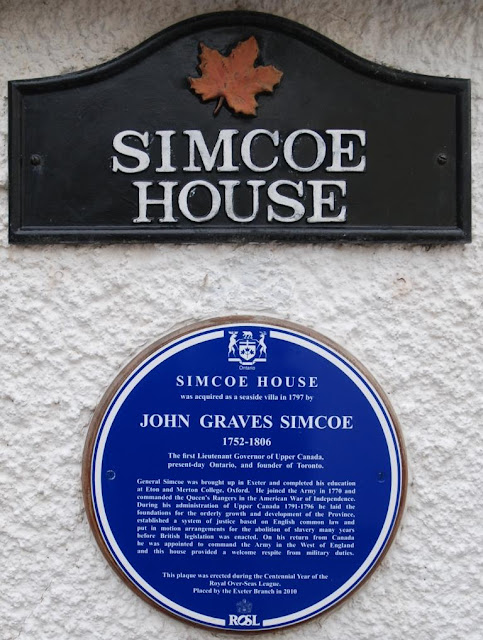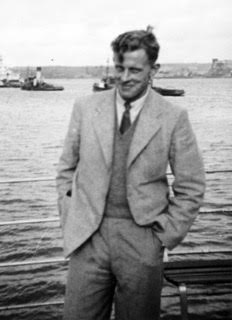Budleigh Notables: S
Professor Herman SCHIRMACHER (c.1818-1901), musician, lived at Elvestone, Fore Street Hill.
* His daughter Dora Schirmacher (1857-1934), pictured above, was a highly successful pianist and composer. It is thought that she may have performed in Budleigh.
https://www.sophie-drinker-institut.de/schirmacher-dora
Walter SCUTT (died early 1940s). Author and printer. He lived at ‘Cranford’, Mansfield Terrace. Pictured are pages from his 1936 book about East Budleigh and ‘Hayes Barton’.
* He wrote and printed two other books illustrated with his own engravings: Otterton, a Village of East Devon (1935), and Pride of Devon (1938).
* He was a close friend of George Edward Lovelace Carter (1886-1974).
William Henry ‘Curly’/'Bill' SEDGEMORE (1867-1943). Budleigh fisherman. He lived at 21 Queen Street. Pictured: The Sedgemores – a family of fishermen. Photo courtesy of Nick Loman.
* He is featured in the book Budleigh Salterton in Bygone Days (1987) by Walter James ‘Jim’ Gooding (1904-1986).
* He named his son Russell in honour of bank manager Hubert Barnard Russell (1856-1917), who organised a public subscription to offer financial help to him. following an accident when his boat and catch had been lost at sea.
* He owned the first motorized fishing boat in Budleigh.
* He was buried with his wife Jemima, née Paver (1867-1965), in St Peter’s Burial Ground, Moor Lane.
Marmaduke SHEILD MB, FRCS (1858-1922), physician and surgeon, lived at 'Lark Barrow', West Hill.
* He campaigned on behalf of Budleigh fishermen in the post-WW1 era, when the continuing intensity of naval activity on this part of the coast made it difficult for many to earn a living from the sea. A letter that he addressed to the local MP, Major Morrison Bell, was copied to the Editor of The Daily Gazette on 1 July 1921:
I am writing on behalf of the fishermen here to implore your immediate aid and intervention in a matter which virtually affects them.
The naval manoeuvres, soon to take place, are to be held on a sea area where the men gain their living at this time of year - the crab and lobster grounds.
It seems strange, with a Fishers and Admiralty Board, that such a locality should have been selected. I do not see why the exercise could not take place some three miles further out, and clear the area altogether.
These men have sunk much money in gear, pots, motor boats and so on, and their case is indeed a hard one. Many of them are ex-Service men to whose bravery and devotion in the horrors of the late war the whole country testifies.
On all grounds, therefore, this order should at once be reconsidered, and I trust that you and other Members of Parliament along this part of the coast of Devon, will at once raise the question in the House.
I am, your obedient servant,
A. MARMADUKE SHEILD MB, FRCS
* By his will he established the Marmaduke Sheild Fund at Cambridge University. It initially funded the Sheild Readership in Pharmacology and medical scholarships which are awarded to the present day. In 1946 Cambridge University honoured Sheild by naming its newly established chair in Pharmacology in his name.
http://en.wikipedia.org/wiki/Marmaduke_Sheild
http://fairlynchgreatwar.blogspot.com/2014/09/fishing-for-navy.html
General John Graves SIMCOE (1752-1806) lived at what is now ‘Simcoe House’, Fore Street Hill. Blue plaque on site.
* As commander of the Queen’s Rangers during the American War of Independence, he is credited by some to have saved the life of the first president of the United States. It is said that he ordered his men not to shoot three fleeing American rebels in the back, considering such an action to be dishonourable, One of the rebels was supposedly George Washington (1732-1799).
* He is credited with composing what is considered to be the first Valentine card in America.
* As Lieutenant-Governor of Upper Canada he abolished slavery in that part of America. ‘The principles of the British Constitution are fundamentally at odds to that vile practice of slavery which Christianity condemns,’ he wrote. ‘When I assume the governorship of Upper Canada I shall never allow discrimination by dishonest practice against those of African, Indian or American descent.’
* His grave is at Wolford Chapel, near Honiton, where the Canadian flag flies, signifying that it is territory of the Canadian province of Ontario despite being in the English countryside.
* While commander of the West of England forces on Woodbury Common during the Napoleonic Wars, Simcoe was challenged to a duel by local landowner Lord Rolle (1756-1842). The issue was the ownership of ‘horse shit’, as described by Canadian historian Adam Bunch in the blogpost below.
https://spacing.ca/toronto/2015/08/04/john-graves-simcoe-napoleon-bonaparte-politics-horse-shit/
https://budleighpastandpresent.blogspot.com/2009/05/cape-cod-and-otter-valley-closer-than.html (15 May 2009)
https://simple.wikipedia.org/wiki/John_Graves_Simcoe
Edward ‘Ted’ Henry SIMPSON (1838-1922). Company director. He lived at ‘Highfield’, Sherbrook Hill.
* His father William Butler Simpson founded the decorating firm of W B Simpson in 1833; his innovative designs, particularly in wallpapers, earned him a gold medal from The Society of Arts in 1849 and a bronze medal from the International Exhibition of Decorators in 1851.
* In 1852, Ted and his elder brother were apprenticed to the firm and were made partners in 1860; the firm was now called W B Simpson & Sons. They traded from 456 West Strand, opposite the Grand Hotel, but in 1868 moved to premises built by the sons at 100 St Martins Lane. The whole of the upper floors of 100 St Martins Lane was used as tile painting studio and for Mosaic and Ecclesiastical “Opus Sectile” panels and stained glass.
* W B Simpson & Sons had and still has the largest contract ever undertaken by a single tile company, supplying the London Underground as seen in the photos above.
* Ted Simpson retired in 1894, moving to ‘Highfield’ in Budleigh with his first wife Kate Simpson, née Roberts (1850-1911).
* Kate Simpson, née Roberts, died in hospital at Exeter. She was buried in St Peter’s Burial Ground, Moor Lane.
* Ted Simpson married his second wife Mary Robinson (b.1871). She was still living at ‘Highfield’ in 1939 according to Kelly’s Directory.
https://www.badseysociety.uk/sladden-archive/people/136

Henry Hawley SMART (1833-93), author, lived at Laburnum Cottage, West Hill.
* He started writing novels after losing money on unlucky horse racing bets.
* He was listed in the ‘Novelist’ category in a poll on ‘Who are the Greatest Living Englishmen?’ published in the Pall Mall Gazette in 1885.
* His grave and that of his wife Alice Ellen, née Smart (1854-1927), is in All Saints’ churchyard, East Budleigh. She was the daughter of John Smart, of Budleigh Salterton.
http://segalbooks.blogspot.com/2009/06/life-and-death-in-budleigh.html
https://en.wikipedia.org/wiki/Henry_Hawley_Smart
Sir Robert SMIRKE (1781-1867). Architect. Lived for a time at Chapel Terrace, now known as East Terrace. Image credit: Wikipedia, showing his bust in the British Museum.
* He was a leader of Greek Revival architecture as seen in his best known works in London: the General Post Office in St. Martin's-le-Grand and the British Museum.
https://en.wikipedia.org/wiki/Robert_Smirke_(architect)
Laurence SPALTON (1919-2011) Pharmacist Author of Pharmaceutical Emulsions and Emulsifying Agents (1949). Lived at 6 Marine Parade.
* If you’ve taken Panadol or Paracetamol for a headache or to relieve pain you should thank him for inventing them while he was working for Bayer Ltd in 1956.
* On retiring to Budleigh in 1979 he developed an interest in the local wild flowers and was Chairman of the Botany Section of the Devonshire Association from 1994 to 1996.
Joan SPINK, aka Joan Bennett (1901-1983), musician, lived at Corner Cottage, Fore Street; later at Pagets 11 Westfield Road; later at ‘Lace Acre’ on Boucher Road. Also at ‘Applecot’, 16 Upper Stoneborough Lane
* A pupil of the composer Gustav Holst, she was also a member of the Society of Women Composers. Above is a programme of items performed on 3 November 1922 at Novello Hall in London, including her arrangement of Irish songs.
* The Bennett family fled from London air raids in WW2 and settled in Budleigh thanks to the suggestion of Joyce Dennys (1893-1991).
https://budleighpastandpresent.blogspot.com/2014/11/museum-scores-precious-find-for.html (3 Nov 2014)
Sir Malcolm Keith SYKES FRCA FFARCS (1925-2019) Anaesthesia educator. He and his wife Michelle settled at 'Treyarnon' on Cricketfield Lane in 2002.
* He is the author of books about the treatment of respiratory failure, and the history of anaesthesia. His book Anaesthesia and the Practice of Medicine was published in 2007.
https://en.wikipedia.org/wiki/Keith_Sykes_(anaesthetist)














Comments
Post a Comment